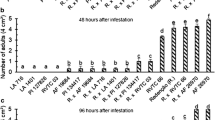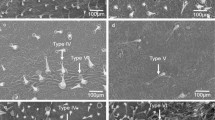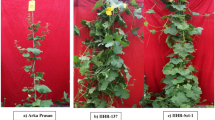Abstract
Thirty-two accessions of wild tomato (Lycopersicon spp.) germplasm were evaluated for resistance to the whiteflyBemisia argentifolii Bellows ⇐p; Perring in a greenhouse choice bioassay. Density data were recorded for the adaxial and abaxial leaf surfaces for (i) all life stages ofB. argentifolii and (ii) types I, IV, V and VI trichomes. Individual plant selections (33 from 22 wild tomato accessions) with high resistance were subsequently tested in the field to verify the resistance found in the greenhouse screening. Resistance was defined by the density of all life stages of the whitefly observed on the eight leaflets sampled at nodes 5 and 7. Only type IV trichomes had a consistent (but low) and significant negative correlation between trichome density and whitefly density for various life stages. The highest whitefly resistance was observed inLycopersicon pennellii accessions LA 716, LA 1340 and LA 2560. The most resistantL. hirsutum f.typicum accessions were LA 1777 and LA 1353.
Similar content being viewed by others
References
Augustine, J.J., Harbaugh, B.K. and Crill, J.P. (1981) Florida Lanai a dwarf tomato for the patio.Fla. Agric. Exp. Stn. Circ. S-284.
Barten, J.H.M., Stevens, M.R., Schuster, D.J., Scott, J.W. and Chambliss, O.L. (1995) Evaluating resistance in tomato to the silverleaf whiteflyBemisia argentifolii Bellows & Perring.Phytoparasitica 22:330–331.
Berlinger, M.J., Dahan, R. and Shevach-Urkin, E. (1983) Breeding for resistance in tomato to the tobacco whitefly (Bemisia tabaci).Phytoparasitica 11:132 (abstr.).
Butler, G.D. Jr. and Henneberry, T.J. (1991) Sweetpotato whitefly control: effect of tomato cultures and plant derived oils.Southwest. Entomol. 16:37–43.
Carter, C.D., Gianfagna, T.J. and Sacalis, J.N. (1989) Sesquiterpenes in glandular trichomes of a wild tomato species and toxicity to the Colorado potato beetle.J. Agric. Food Chem. 37:1425–1428.
Channarayappa, S.G., Muniyappa, V. and Frist, R.H. (1992) Resistance ofLycopersicon species toBemisia tabaci, a tomato leaf curl virus vector.Can. J. Bot. 70:2184–2192.
de Ponti, O.M.B., Romanow, L.R. and Berlinger, M.J. (1990) Whitefly-plant relationships: plant resistance.in: Gerling, D. [Ed.] Whiteflies: Their Bionomics, Pest Status and Management. Intercept Ltd., Andover, Hants, UK. pp. 91–107.
Dittrich, V., Uk, S. and Ernst, G.H. (1990) Chemical control and insecticide resistance of whiteflies.in: Gerling, D. [Ed.]. Whiteflies: Their Bionomics, Pest Status and Management. Intercept Ltd., Andover, Hants, UK. pp. 263–285.
Eigenbrode, S.D. and Trumble, J.T. (1993) Antibiosis to beet armyworm (Spodoptera exigua) inLypersicon accessions.HortScience 28:932–934.
Fery, R.L. and Kennedy, G.G. (1987) Genetic analysis of 2-tridecanone concentration, leaf trichome characteristics, and tobacco hornworm resistance in tomato.J. Am. Soc. Hortic. Sci. 112:886–891.
Gentile, A.G. and Stoner, A.K. (1968) Resistance inLycopersicon andSolanum species to the potato aphid.J. Econ. Entomol. 61:1115–1154.
Gentile, A.G., Webb, R.E. and Stoner, A.K. (1968) Resistance inLycopersicon andSolanum to greenhouse whiteflies.J. Econ. Entomol. 61:1355–1357.
Gentile, A.G., Webb, R.E. and Stoner, A.K. (1969)Lycopersicon andSolanum spp. resistant to the carmine and two-spotted spider mite.J. Econ. Entomol. 62:834–836.
Gianfagna, T.J., Carter, C.D. and Sacalis, J.N. (1992) Temperature and photoperiod influence trichome density and sesquiterpene content ofL. hirsutum f.hirsutum.Plant Physiol. 199:1403–1405.
Good, D.E. Jr. and Snyder, J.C. (1988) Seasonal variation of leaves and mite resistance ofLycopersicon interspecific hybrids.HortScience 23:891–894.
Guo, Z., Weston, P.A. and Snyder, J.C. (1993) Repellency to two-spotted spider mite,Tetranychus urticae Koch, as related to leaf surface chemistry ofLycopersicon hirsutum accessions.J. Chem. Ecol. 19:2965–2979.
Hawthorne, D.J., Shapiro, J.A., Tingey, W.M. and Mutschler, M.A. (1992) Trichome-borne and artificially applied acylsugars of wild tomato deter feeding and oviposition of the leafminerLiriomyza trifolii.Entomol. Exp. Appl. 65:65–73.
Heinz, K.M. and Zalom, F.G. (1995) Variation in trichome-based resistance toBemisia argentifolii (Homoptera: Aleyrodidae) oviposition on tomato.J. Econ. Entomol. 88:1494–1502.
Hochmuth, G.J., Maynard, D.N., Vavrina, C.S., Stall, W.M., Kucharek, T.A., Stansly, P.A.et al. (1999) Tomato production in Florida.in: Maynard, D.N. and Hochmuth, G.J. [Eds.] Vegetable Production Guide for Florida. SP 170, pp. 238–241. University of Florida, Gainesville, FL, USA.
Hogenboom, N.G. (1972) Breaking breeding barriers inLycopersicon. 1. The genusLycopersicon, its breeding barriers and the importance of breaking these barriers.Euphytica 21:221–227.
Juvik, J.A., Berlinger, M.J., Ben-David, T. and Rudich, J. (1982) Resistance among accessions of the generaLycopersicon andSolanum to four of the main insect pests of tomato in Israel.Phytoparasitica 10:145–156.
King, R.R., Calhoun, L.A., Singh, R.P. and Boucher, A. (1990) Sucrose esters associated with glandular trichomes of wildLycopersicon species.Phytochemistry 29:2115–2118.
Liedl, B.E., Lawson, D.M., White, K.K., Shapiro, J.A., Cohen, D.E., Carson, W.G.et al. (1995) Acylsugars of wild tomatoLycopersicon pennellii alters settling and reduces oviposition ofBemisia argentifolii (Homoptera: Aleyrodidae).J. Econ. Entomol. 88:742–748.
Lin, S.Y.H., Trumble, J.T. and Kumamoto, J. (1987) Activity of volatile compounds in glandular trichomes ofLycopersicon species against two insect herbivores.J. Chem. Ecol. 13:837–850.
Luckwill, W.C. (1943) The genusLycopersicon, an historical, biological and taxonomic survey of the wild and cultivated tomatoes. Aberdeen Univ. Studies No. 120, Aberdeen Univ. Press, Aberdeen, UK.
Monforte, A.J. and Tanksley, S.D. (2000) Development of a set of near isogenic and backcross recombinant inbred lines containing most of theLycopersicon hirsutum genome in aL. esculentum genetic background: A tool for gene mapping and gene discovery.Genome 43:803–813.
Muigai, S.G., Schuster, D.J., Snyder, J.C., Scott, J.W., Bassett, M.J. and McAuslane, H.J. (2002) Mechanisms of resistance inLycopersicon germplasm to the whiteflyBemisia argentifolii.Phytoparasitica 30:347–360.
Perring, T.M., Cooper, A.D., Rodriguez, R.J., Farrar, C.A. and Bellows, T.S. Jr. (1993) Identification of a whitefly species by genomic and behavioral studies.Science 259:74–77.
SAS Institute. (1988) SAS/STAT User’s Guide. SAS Institute, Cary, NC, USA.
Schuster, D.J. (1977) Resistance in tomato accessions to the tomato pinworm.J. Econ. Entomol. 70:434–436.
Schuster, D.J. (1998) Intraplant distribution of immature lifestages ofBemisia argentifolii (Homoptera: Aleyrodidae) on tomato.Environ. Entomol. 27:1–9.
Schuster, D.J. (2001) Relationship of silverleaf whitefly density to severity of irregular ripening of tomato.HortScience 36:1089–1090.
Schuster, D.J., Funderburk, J.E. and Stansly, P.A. (1996) IPM in tomatoes.in: Rosen, D., Capinera, J.L. and Bennet, F.D. [Eds.] Integrated Pest Management — A Florida Perspective. Intercept Ltd., Andover, Hants, UK. pp. 387–411.
Schuster, D.J., Stansly, P.A. and Polston, J.E. (1996) Expressions of plant damage byBemisia.in: Gerling, D. and Mayer, R.T. [Eds.]Bemisia: 1995 Taxonomy, Biology, Damage, Control and Management. Intercept Ltd., Andover, Hants, UK. pp. 153–165.
Scott, J.W., Stevens, M.R., Barten, J.H.M., Thome, C.R., Polston, J.E., Schuster, D.J.et al. (1996) Introgression of resistance to whitefly-transmitted geminiviruses fromLycopersicon chilense to tomato.in: Gerling, D. and Mayer, R.T. [Eds.]Bemisia: 1995 Taxonomy, Biology, Damage, Control and Management. Intercept Ltd., Andover, Hants, UK. pp. 357–367.
Sharaf, N. (1986) Chemical control ofBemisia tabaci.Agric. Ecosyst. Environ. 17:11–127.
Snyder, J.C., Simmons, A.M. and Thacker, R.R. (1998) Attractancy and ovipositional response of adultBemisia argentifolii (Homoptera: Aleyrodidae) to Type IV trichome density on leaves ofLycopersicon hirsutum grown in three day-length regimes.J. Entomol. Sci. 33:270–281.
Sorenson, C.E., Fery, R.L. and Kennedy, G.G. (1989) Relationship between Colorado potato beetle (Coleoptera: Chrysomelidae) and tobacco hornworm (Lepidoptera: Sphingidae) resistance inLycopersicon hirsutum f.glabratum.J. Econ. Entomol. 82:1743–1748.
Stansly, P.A., Schuster, D.J. and Leibee, G.L. (1991) Management strategies for the sweetpotato whitely.in: Vavrina, C.S. [Ed.] Proc. Florida Tomato Institute. Vegetable Crops Special Series SS-VEC-01, pp. 20–42. University of Florida, Gainesville, FL, USA.
Weston, P.A., Johnson, D.A., Burton, H.T. and Snyder, J.C. (1989) Trichome secretion composition, trichome densities, and spider mite resistance of ten accessions ofLycopersicon hirsutum.J. Am. Soc. Hortic. Sci. 114:492–498.
Author information
Authors and Affiliations
Corresponding author
Additional information
http://www.phytoparasitica.org posting Dec. 9, 2002.
Rights and permissions
About this article
Cite this article
Muigai, S.G., Bassett, M.J., Schuster, D.J. et al. Greenhouse and field screening of wildLycopersicon germplasm for resistance to the whiteflyBemisia argentifolii . Phytoparasitica 31, 27–38 (2003). https://doi.org/10.1007/BF02979764
Received:
Revised:
Issue Date:
DOI: https://doi.org/10.1007/BF02979764




